 The Main Street of Mogollon is highly reminiscent of Bisbee, Az - complete with arroyo
The Main Street of Mogollon is highly reminiscent of Bisbee, Az - complete with arroyo The journey is half the adventure, as Mogollon lies a half-dozen vertical miles off of Hwy 180 and it’s a narrow windy bit that can give those of delicate constitutions the vapors, but once there the town itself is a quaint village nestled in a deep valley that reminded me of Bisbee, AZ – another late 19th century mining town.
Founded in 1889, Mogollon enjoyed the typical boom of a mining town, followed by the bust that folllows; in the early 20th century the mines were producing wealth for all, but by WW1 they had virtually all been shut down. The mines reopened during WW2 for a time, and even the Little Fanny Mine hung on the longest, producing until the early 1950s when it too shut down forever.
Now a berg of scarcely over 25 souls, Mogollon seems to hang on out of sheer will and memory of its former glory. There is a museum, a few private homes, the Purple Onion Cafe, and not much more.
But its remains honor the history of the boomtown mining camps of a hundred plus years ago, and there are historic structures and a cemetery at the top of the canyon that bears witness to the struggles of our forebears. There are no t-shirts, really, or trinkets to buy, only the experience of visiting, which in a town like Mogollon, is more than enough.




 RSS Feed
RSS Feed
